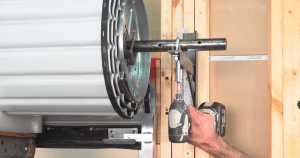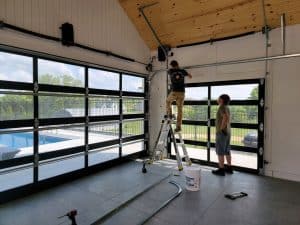Garage door stuck open? Here’s how to fix a garage door that won’t close all the way with quick, proven solutions from experts you can trust.
A garage door that won’t close all the way is more than an inconvenience. It can pose serious security and safety concerns. This common issue often leaves homeowners asking, “How do you fix a garage door that won’t close all the way?” Fortunately, you can try several quick and effective steps before calling a professional.
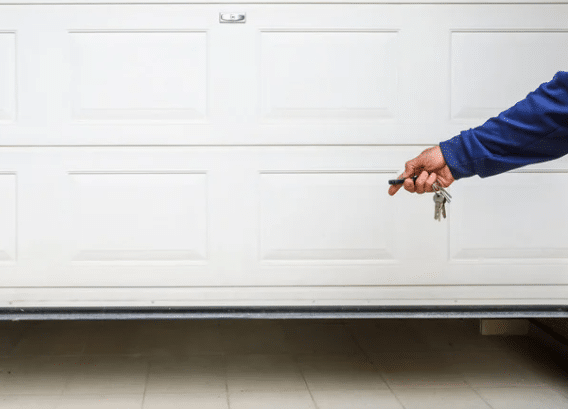
Your garage door may stop short for several reasons, such as misaligned sensors, track obstructions, or incorrect opener settings. Pinpointing the root cause is the first step toward getting your door working properly again.
In this guide, we’ll provide five practical solutions to help you troubleshoot and fix the problem. We’ll also discuss when it’s best to bring in a technician and how regular maintenance can help you avoid similar issues in the future. You’ve come to the right place if you’re looking for answers.
Sensor Check: Misalignment Could Be the Cause
A garage door that won’t close properly often results from an issue with the safety sensors. These sensors are installed on either side of the door, just a few inches above the ground. They are critical in preventing the door from closing if an object, person, or pet is in the way. When the sensors malfunction or become misaligned, the door may stop or reverse direction. If you’re asking yourself, “How do you fix a garage door that won’t close all the way?” A good first step is to check these sensors—make sure they’re clean, aligned, and receiving power.
1. Locate and Inspect the Sensors
Start by identifying the two safety sensors mounted near the bottom of the garage door tracks. Inspect them to ensure they are not damaged or knocked out of position. Each sensor should face the other directly to allow a clear, uninterrupted signal.
2. Check the Indicator Lights
Most sensors have LED indicator lights that help determine if they function correctly. A solid light indicates proper alignment, while blinking or unlit LEDs signal a problem. If one or both lights are blinking, gently adjust the sensors until both lights stay solid.
3. Clean the Sensor Lenses
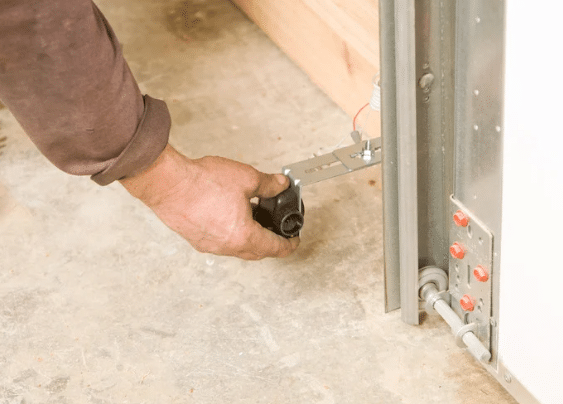
Dust, dirt, or spiderwebs on the lenses can block the infrared signal between the sensors. Use a soft, dry cloth to wipe each lens clean gently. Avoid harsh chemicals or abrasive cloths, which can damage the sensor surfaces or leave residue behind.
4. Examine the Wiring
Inspect the wires connected to each sensor if aligning and cleaning the sensors does not resolve the issue. Look for signs of wear, fraying, corrosion, or loose connections. Damaged wiring can interrupt power or communication between the sensors.
5. Test the Door
After performing these checks and adjustments, try closing the garage door. The door should close smoothly if the sensors are correctly aligned and clean. If not, refer to your garage door opener’s manual for further troubleshooting or call a technician for professional assistance.
Clear the Tracks: Obstructions Can Interfere with Closure
1. Inspect the Door Tracks Thoroughly
One of the simplest yet most overlooked causes of a garage door that won’t close fully is an obstruction in the tracks. Small objects like rocks, leaves, or built-up dirt can get lodged in the tracks and disrupt the smooth movement of the door.
Carefully examine both sides of the track from top to bottom. Use a flashlight to check for debris or buildup that may be hard to see. Remove any foreign objects you find, and use a damp cloth or brush to clean out dust or grime that could affect performance.
2. Check for Physical Damage or Warping
In addition to blockages, the condition of the track itself is important. Look closely for signs of bending, dents, or warping along the metal rails. A misaligned or damaged track can cause the door to jam or stop before closing completely.
If you notice significant bending or the track appears uneven, it may require realignment. Minor adjustments can sometimes be made at home, but for severe damage or persistent problems, it’s best to contact a garage door technician to ensure the repair is done safely and correctly.
3. Perform a Test Run
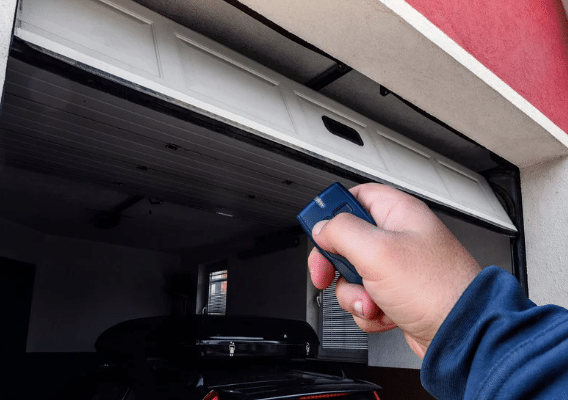
Try operating the garage door again after clearing the tracks and checking for damage. If it now closes smoothly and completely, the obstruction or alignment issue was likely the cause. If not, continue troubleshooting with other components, such as the sensors or the opener system.
Adjust the Limit Settings on Your Opener
1. Understand the Purpose of Limit Settings
Garage door openers include limit settings that control how far the door travels during opening and closing. These settings ensure the door stops at the right point. If the closing limit is too high, the opener may think the door has reached the floor when it’s still slightly open. As a result, the door may stop short or reverse unnecessarily.
2. Locate the Adjustment Controls
To make adjustments, first consult your garage door opener’s user manual. Most units feature two adjustment screws or dials labeled “Up” and “Down” or “Open” and “Close.” These are usually located on the side or back of the motor housing. On newer models, you may find digital limit settings accessible through a control panel or keypad.
3. Make Small Adjustments and Test the Door
Turn the “Down” or “Close” limit screw in small increments—usually one full turn adjusts the stopping point slightly. After each adjustment, test the door by closing it to see if it now seals properly at the bottom.
Make slow, gradual changes. Over-adjusting can cause the door to close too hard, potentially damaging the system or creating a safety hazard.
4. Test the Safety Reverse Feature
Once the limits are set correctly, place a small object like a block of wood under the door and try to close it. Upon contact, the door should immediately reverse. This step is essential to ensure the safety mechanism still works correctly after adjusting the limits.
Look at the Remote and Wall Switch Functionality
1. Check the Control Systems
If your garage door won’t close properly, the problem may not be with the door itself but with the remote or wall switch. Test both controls to determine if one is unresponsive. If the remote doesn’t work but the wall switch does, try replacing the batteries in the remote. If that doesn’t help, the remote may need replacing.
Conversely, the wall unit could be faulty or disconnected if the wall switch is unresponsive and the remote works. Inspect the wiring if you’re comfortable, or consult a technician for assistance.
2. Try Resetting the Opener
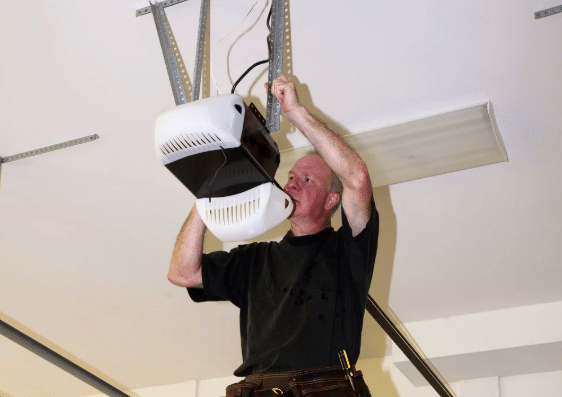
Sometimes, internal software glitches in the opener can interfere with regular operation. Try resetting the unit by unplugging it from the power outlet for about 30 seconds. Plug it back in and test the door again. This simple reset can often resolve temporary communication or memory issues affecting the opener system.
Check for Broken or Damaged Hardware
1. Inspect Springs, Cables, and Rollers
Mechanical issues with your garage door’s hardware can also prevent it from closing completely. Torsion springs, extension springs, cables, and rollers are critical in smooth door operation. If components are broken, loose, or worn out, the door may stop mid-cycle or behave unpredictably.
2. Watch and Listen for Warning Signs
Operate the door manually or with the opener and observe how it moves. Listen for grinding, squeaking, or rattling noises, which can signal worn-out or misaligned parts. Look for visible damage to the cables or signs of rust or bending in the springs and rollers.
3. Know When to Call a Professional
While you can apply garage door lubricant to squeaky rollers or hinges, a trained technician should handle any issue involving springs or cables. These components are under high tension and can be dangerous to adjust or replace without the right tools and expertise.
Frequently Asked Questions
Why isn’t my garage door closing all the way?
Your garage door might not close fully because of misaligned safety sensors, a blockage in the tracks, or incorrect limit settings on the opener. Worn-out rollers or a damaged cable can also prevent it from closing properly. Blinking lights on the opener often indicate what needs attention.
How to fix a door that won’t close all the way?
Check the safety sensors to ensure they are aligned and clean. Adjust the close-limit setting on the opener to allow the door to lower further. Also, inspect for any objects or damage blocking the door’s path.
How to adjust the garage door side gap?
Loosen the track brackets on the side where the gap appears. Gently move the track inward to close the gap, then tighten the bolts securely. Test the door to make sure it moves smoothly and seals evenly.
Why is my garage door shifted to one side when I close it?
Your garage door may shift to one side due to uneven cable tension, a bent track, or worn rollers. This causes one side to close faster than the other, which, if not corrected, can lead to further damage or complete failure.
How to fix a garage door that closes unevenly?
Inspect both cables and springs for wear or imbalance. If one side is lower, it may need a spring adjustment or cable replacement. For safety reasons, a professional should handle tension adjustments.
Conclusion
If your garage door won’t close all the way, the issue is often something simple like sensor misalignment or track debris. These quick fixes can usually be handled with basic tools and a few minutes of your time. Knowing how to fix a garage door that won’t close all the way can save you from costly emergency service calls.
However, some problems, like damaged springs or limit-setting failures, can pose safety risks and should be handled by trained professionals. Recognizing when to call for help is just as important as knowing what you can fix yourself.
If these solutions don’t work or you’re unsure about attempting a repair, contact Superior Door for expert guidance and service. We’re here to keep your garage door running smoothly and your home secure.
End Note
Superior Door is your go-to garage door repair and installation provider throughout the greater Omaha metro area. Our expert garage door repair services are designed to alleviate these concerns and quickly solve your garage door woes.
Whether you need garage door repair, full garage door replacement, or expert installation, we’re equipped to handle every project. From emergency fixes to regular residential or commercial services, we’re ready to help.
Learn more about our team, view our project gallery and videos, and follow us on Facebook and Instagram. Prefer in-person? Find us easily via Google Maps or check out our stellar reviews on Yelp. For fast, reliable service you can count on, choose Superior Door.
Superior Door
8840 S 137th Cir #3, Omaha, NE 68138, United States
+14025712999

